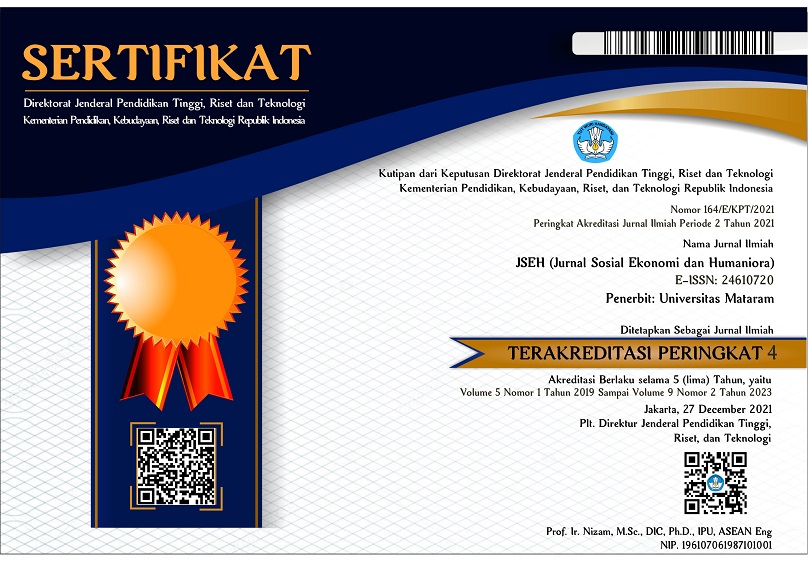KONSENTRASI SPASIAL DAN SPESIALISASI SEKTOR EKONOMI WILAYAH
DOI:
https://doi.org/10.29303/jseh.v7i2.34Keywords:
economic structure, sector, localization, specializationAbstract
This study examines the economic structure of Rokan Hilir Regency from 2011 to 2020 using indicators of localization and specialization in 17 sectors. This study utilizes the Gross Regional Domestic Product data published by the Central Bureau of Statistics of Rokan Hilir Regency. Two models are used empirically: (i) localization quotient and (ii) specialization coefficient. The results of the analysis show that the economic sector of Rokan Hilir Regency relies on the mining and quarrying sector, as well as the agriculture, fishery, and forestry sectors, with the remaining fifteen sectors classified as non-basic. Seventeen economic sectors in Rokan Hilir Regency have a coefficient of specialization less than one, indicating that there is no prominent sector with significant development or specialization between 2011 and 2020.
References
Glaeser, E., Rosenthal, S., Strange, W. (2010). Urban economics and entrepreneurship. Journal of Urban Economic, 67, 1–14
Aiginger, K., Rossi-Hansberg, E. (2006). Specialization and Concentration: A Note on Theory and Evidence. Empirica 2006, 33, 255–266
Chowdhury, M.T.H., Bhattacharya, P., Mallick, D., Ulubasoglu, M.A. (2014). An Empirical Inquiry into the Role of Sectoral Diversification in Exchange Rate Regime Choice. European Economic Review 67, 2210–2227
Rodrik, D. (2013). Unconditional Convergence in Manufacturing. Qwarterly Journal Economic, 128, 165–204
McCausland, W.D. and Theodossiou, I. (2012). Is Manufacturing Still the Engine of Growth? Journal of Post Keynesian Econonomic, 35, 79–92
Kathuria, V. and Natarajan, R.R. (2013). Manufacturing an Engine of Growth in India in the Post-Nineties? Journal of South Asian Devevelopment, 8, 385–408
Güçlü, M. (2013). Manufacturing and Regional Economic Growth in Turkey: ASpatial Econometric Viewof Kaldor’s Laws. European Planning Studies, 21, 854–866.
Mardiana, Tampubolon, D., Utami, B.C. Handoko, T. (2021). Perubahan Pekerjaan Di Kabupaten Kampar Selama Wabah Covid-19: Analisis Dekomposisi Sektoral. Juremi: Jurnal Riset Ekonomi, 1 (2), 95–104.
Szirmai, A. and Verspagen, B. (2015). Manufacturing and Economic Growth in Developing Countries, 1950–2005. Structural Change Economic Dynamic, 34, 46–59
Haraguchi, N., Cheng, C.F.C., Smeets, E. (2017). The Importance of Manufacturing in Economic Development: Has This Changed? World Devevelopment, 93, 293–315
Zhao, J. and Tang, J. (2018). Industrial Structure Change and Economic Growth: A China-Russia Comparison. China Economic Review, 47, 219–233
Akmadani, J., Tampubolon, D., Aulia, A.F. (2021). Analisis Pertumbuhan Ekonomi dan Pengembangan Sektor Potensial Kabupaten Indragiri Hilir. Triangle: Journal of Management, Accounting, Economic and Business, 2 (2), 91 - 102
Brakman, S., Garretsen, H., van Marrewijk, C. (2001). An Introduction to Geographical Economics. Cambridge, UK: Cambridge University Press.
Ceapraz, I. L. (2008). The concepts of specialisation and spa-tial concentration and the process of economic integration: theoretical relevance and statistical measures. The case of Romania’s regions. Romanian Journal of Regional Science, 2(1), 68-93
Falcıoğlu, P. (2011). The relation between geographical place and innovativeness: the case of Turkey. International Journal of Emerging and Transition Economies, 4(1-2), 75-95.
Falcıoğlu, P., and Akgüngör, S. (2008). Regional specialization and in-dustrial concentration patterns in the Turkish manufacturing industry: an assessment for the 1980-2000 period. European Planning Studies, 16(2):303-323.
Farhauer, O., and Kröll, A. (2012). Diversified specialisation going one step beyond regional economics’ specialization-di-versification concept. Jahrbuch Für Regionalwissenschaft, 32(1), 63-84.
Frenken, K., Van Oort, F., Verburg, T. (2007). Related variety, unrelated variety and regional economic growth. Regional studies, 41(5), 685-697.
Hidayat, M., dan Darwin, R. (2017). Analisis Sektor Potensial Dalam Memacu Pembangunan Wilayah Kabupaten Kepulauan Meranti. Prosiding CELSciTech: Urgensi Riset dan Pengembangan Teknologi Informasi Dalam Mengatasi Masalah Bangsa, 02, Eco 18 - 26
Peker, Z. (2012). Specialization, diversity and region size. Vizyoner Dergisi, 3(6), 1-25.
Suedekum, J. (2006). Concentration and specialization trends in Germany since re-unification. Regional Studies, 40(8), 861-873.
Downloads
Published
How to Cite
Issue
Section
License

This work is licensed under a Creative Commons Attribution-NonCommercial 4.0 International License.








